Scientific name: Ulmus pumila
Pronunciation: UL-mus pu-MIL-a
Common names: Siberian elm, Asiatic elm, dwarf elm, but not Chinese elm (they are Ulmus parviflora)
Family: Ulmaceae
Article by Jeanne Gozigian
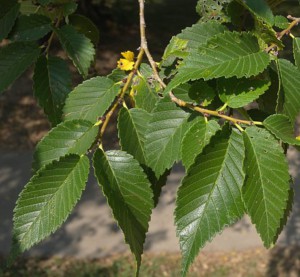
Photo by John Hilty, Illinois Wildflowers
Ah, Siberian elms, the trees I loved to hate!
When I was the chair of the landscape committee in my neighborhood in northwest Santa Fe County in New Mexico, my mission was to eradicate these “trash trees.” They tended to grow close to our precious, expensively paved (with association funds) roads, but their mission was to heave pavement with their invasive roots. It is well known that these trees, planted close to houses, can entwine sewer and septic tank lines to their destruction.
I had a hard job ahead of me with the “tree huggers” in my neighborhood. “But they are so beautiful,” they said. Yes, the dark green, 2 ¾ inch long and 1 ¼ inch wide, alternate leaves with oblique base and coarsely serrated edges are attractive in small seedlings, which turn golden in the fall.
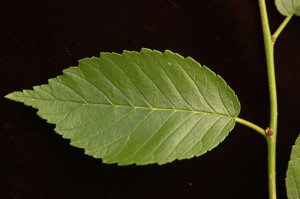
Siberian elm leaf. Photo credit: Pat Breen, Oregon State University.
Never mind that, as Michael A. Dirr, Professor of Horticulture at the University of Georgia, in his “Manual of Woody Landscape Plants” said, Siberian elms are “One of the world’s worst… ornamental trees that do not deserve to be planted anywhere.” The mature trees, typically 40 feet tall and living 60 years in temperate climates, have unattractive, raggedy crowns.
Now I must, in fairness, discuss reasons why there is justification for the inclusion of Siberian elms in New Mexico.
Siberian elms (Ulmus pumila) are native to central Asia, eastern Siberia, the Russian Far East, Mongolia, northern China and India. Ulmus is Latin for elm. The ancient Romans typically used elm posts to support vines in vineyards. Pumila refers to “plants with small leaves and somewhat shrubby habits” (Missouri Botanical Garden), as in dwarf elm. It could also mean early flowering, as the small green flower clusters can appear before the leaves. They were brought to the United States and Europe because they were resistant to Dutch elm disease (DED), which was ravaging historic stands of American elms. The scientific name for DED is Ophiostoma ulmi and it is probably originated in the Asiatic region. Siberian elms are able to withstand the extreme cold of Mongolia and the heat and drought conditions of the Gobi Desert. The trees are deciduous in cold areas and semi-evergreen in warmer climates. Governor Clyde Tingley brought them to Albuquerque, New Mexico, in the Dust Bowl era as a solution to the shadeless, drought-prone areas of the city.
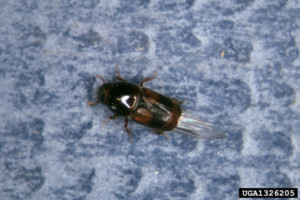
Banded elm bark beetle (Scolytus schevyrewi)
by Whitney Cranshaw, Colorado State University, Bugwood.org
Dutch elm disease is caused by sac fungi (Ascomycota) that are carried by elm bark beetles. It moved from Asia to Europe to the United States. Native to the US, elm bark beetles (Hylurgopinus rufipes) were not so destructive. Ophiostoma ulmi infected beetles that reached Europe in 1910 and America in 1928. Scolytus schevyrewi – the non-native banded bark beetle arrived in Colorado and Utah in 2003, spelling doom for American elms. The vector is thought to have been from a shipment of logs from the Netherlands to supply veneer for Ohio furniture makers. Estimates are that 75% of American elms were lost by 1989.
DED attacks the vascular tissues of elms, the xylem and phloem, preventing water and nutrients from reaching the plant, starving and killing it. Upper branches wither and yellow, gradually increasing branch dieback and tree death. In the 1940’s DDT and dieldrin sprays were used to attempt control of DED but were thought to be an agent for bird death – American woodcocks, American robins, brown creepers, etc.. Rachel Carson (1907-1964), author of The Silent Spring, preached the disuse of sprays, advocating improved sanitation methods, e.g., cutting and destroying diseased branches.
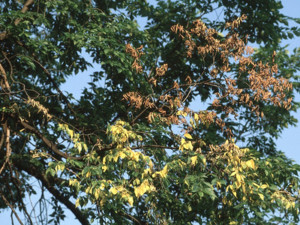
Evidence of Dutch elm disease (Ophiostoma ulmi) on an American elm (Ulnus americana). Photographer: Flickr user Joseph O Brien, USDA Forest Service, Bugwood.org. Original url: http://www.forestryimages.org/browse/detail.cfm?imgnum=1301073 Shared under Creative Commons BY.
By the 1970’s, fungicides became available. Arbotect® 20-S (thiabendazole hypophosphite) was 99.5% effective in protecting elms for three years of beetle infection. Vaccines are being developed to engender immune responses.
So, the search was on for cultivars that were resistant to DED. Siberian elms, not a cultivar, were already becoming invasive in the Southwest and were well established. They grew in disturbed grounds in abandoned lots and along railroads and roadways. Because they needed maximum sunlight they rarely invaded mature forests. They mainly caused problems in cities and open areas. Ulmus pumila spontaneously hybridized with slippery elm (U. rubra) in the US and in Europe with the field elm (U. minor).
Here was the problem: American elm cultivars can become infected and not make it to maturity (60 years). Perhaps we need to look again at Siberian elms.
American elms (Ulmus americana) were the lovely giants with weeping branches lining most of Main Street, USA, in the first half of the twentieth century. Because they were a monoculture connected by their root systems, they were totally vulnerable. DED hit Cleveland, Ohio in 1930. By 1970, 77 million American elms had been killed. Something was needed to replace shade trees in American cities.
Ben Wright, a New Mexico arborist, asked, “What is the Siberian elm doing in New Mexico?” Many reasons, he posits:
- They tolerate extreme environment and grow in disturbed sites.
- They hybridize with other elm species.
- They are resistant to DED.
- They are fast growing, reaching maturity at 10 years.
- Their deep roots allow them to seek water.
The USDA calls Siberian elms a class C noxious weed in New Mexico and it is declared invasive in 25 states. However, these trees are at the core of historical districts in the Southwest and provide the only shade for many areas. In a May 13, 2017, article in the Santa Fe New Mexican newspaper, Nate McDowell, a former Los Alamos National Laboratory scientist, is quoted as saying, “Do you really want to cut down something that is doing OK when other things are dying?”
Though Siberian elms rarely exceed 60 feet, the USA National Champion was 109 feet, 11 inches in 2011 in Berrien County, Michigan. Problems they create in cities and open areas can be ameliorated by pruning, destroying diseased branches and clearing dense patches. It is important to eradicate seedlings as soon as possible and to stage removal and replacement in order to reestablish native vegetation. In the meantime, Siberian elms thrive with little water in drought stricken areas.
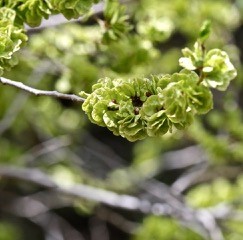
Siberian elm seed. Photo by Janice Tucker.
As always, we like to look for positive traits in plants. Wild Food Girl, Erica Davis, says that elm samaras – papery, light green seed pods formed after flowers and immature fruits – are delicious raw and as salad ingredients. These are the pods that one sees everywhere when they are being shed and account for the widespread dispersal and proliferation of seedlings. Erica has a recipe for a salad that sounds yummy: elm samaras and carrot shavings over salad greens are dressed with horseradish, dill and garlic greens, thinned with milk.
How about using Siberian elm for firewood? It is OK, even if it is a pain to split, being very fibrous. It gives off decent heat, provided it is dried off the ground for 1-2 years. The roots of dead trees are an excellent host for morel mushrooms.
OK, Tree Huggers, I am willing to compromise. I still feel that we need to rid the area of as many Siberian elms as we can while protecting historic stands of shade trees. Let us judiciously replant with non-invasive, drought tolerant, native vegetation.
Consider ginkos, amur maple, honey locust and some oaks. Although these trees will not reach the height of Siberian elms, they will be kinder to those around them.
Thanks to Janice Tucker and Helen Woody for proofreading this article.
Sources:
Beaulieu, David. “Dutch Elm Disease on American Elm Trees. Ulmus Americana Before the Invasion”. The Spruce. 4 Oct 2019. Web. 26 Nov 2019. Retrieved from: https://www.thespruce.com/dutch-elm-disease-on-american-elm-trees-2131195
Davis, Erica M. “Elm samaras are edible, gourmet”. Wild Food Girl. 5 May 2016. Web. 26 Nov 2019. Retrieved from: https://wildfoodgirl.com/2016/elm-samaras-edible-gourmet/
Dirr, Michael. Manual of Woody Landscape Plants: Their Identification, Ornamental Characteristics, Culture, Propagation and Uses. Champaign, Ill: Stipes Pub, 2009. Print.
Greenway, Nick. “Elm Firewood – is it Any Good?”. FIREWOOD-FOR-LIFE.COM. Web. 26 Nov 2019. Retrieved from: https://www.firewood-for-life.com/elm-firewood.html
Whittemore, Frank. “Facts About the Siberian Elm Tree”. Garden Guides. 21 Sept 2017. Web. 26 Nov 2019. Retrieved from: www.gardenguides.com/91812-siberian-elm-tree.html
Harrison, Lorraine. Latin for Gardeners: Over 3,000 Plant Names Explained and Explored. , 2012. Print.
Groundwork Studio. “Socorro Tree Inventory. New Mexico Statewide Community Forest, Analysis and Management Planning”. New Mexico Energy, Minerals and Natural Resources Department and the City of Socorro, NM. 2017. Retrieved from: https://www.socorronm.gov/wp-content/uploads/2018/02/Socorro-Tree-Inventory.Final_.pdf
Moore, Lincoln M. “Siberian Elm”. Plant Fact Sheet. USDA, NRCS, National Plant Data Center. Web. 26 Nov 2019. Retrieved from: https://plants.usda.gov/factsheet/pdf/fs_ulpu.pdf
Moore, Lincoln M. “Siberian Elm”. Plant Guide. USDA, NRCS, National Plant Data Center. Web. 26 Nov 2019. Retrieved from: https://plants.usda.gov/plantguide/pdf/cs_ulpu.pdf
Moss, Rebecca. “Rethinking the dreaded Siberian Elm”. Santa Fe New Mexican. 13 May 2017. Web. 26 Nov 2019. Retrieved from: https://www.santafenewmexican.com/news/local_news/rethinking-the-dreaded-siberian-elm/article_60654cca-f0a3-565a-8909-e36cd7e8d6a6.html
“pumila (Latin)”. WordSense.eu Dictionary. Web. 26 Nov 2019. Retrieved from: www.wordsense.eu/pumila
Stearn, William T. Stearn’s Dictionary of Plant Names for Gardeners, Cassell Publishers Limited, Villiers House, 41/47 Strand, London WC2N 5JE
“Ulmus pumila”. Plant Finder. Missouri Botanical Garden. Web. 26 Nov 2019. Retrieved from: http://www.missouribotanicalgarden.org/PlantFinder/PlantFinderDetails.aspx?kempercode=a925
“Ulmus pumila”. Plants For A Future. Web. 26 Nov 2019. Retrieved from: https://pfaf.org/user/Plant.aspx?LatinName=Ulmus+pumila
“Ulmus pumila”. Wikipedia: The Free Encyclopedia. Wikimedia Foundation, Inc. 19 Nov. 2019. Web. 30 Nov. 2019. Retrieved from: https://en.wikipedia.org/wiki/Ulmus_pumila
Wright, Ben. “What is Siberian Elm Doing in New Mexico?”. 2017. PowerPoint Presentation. Retrieved from: https://www.thinktreesnm.org/images/presentations/2017%20WRIGHT%20Why%20Is%20Siberian%20Elm%20in%20NM.pdf.


